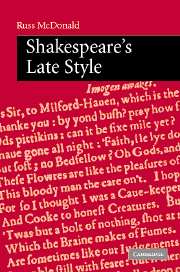Introduction
Published online by Cambridge University Press: 22 September 2009
Summary
“In all of Shakespeare's development,” write C. L. Barber and Richard Wheeler, “there is no change in dramatic style so striking as that between the final tragedies and the late romances.” Barber and Wheeler use the term “dramatic style” loosely, referring chiefly to the theatrical sub-genre and the point of view that selects and informs it. But the sentence is true in a strict sense as well, when “style” is taken to mean syntax, meter, diction, repetition, figurative language, and other such verbal and poetic properties. Around 1607, Shakespeare was drawn to a new kind of story and, at the same time, gave his characters a new kind of poetry to speak. At the beginning of this phase, having completed Macbeth and begun and perhaps finished Coriolanus or Antony and Cleopatra (or perhaps both), he contributed to the completion of Pericles, collaborating with George Wilkins or possibly finishing a play that Wilkins had begun; at the end of this phase, from about 1611 to 1613, he collaborated with John Fletcher on three plays, Henry VIII, The Two Noble Kinsmen, and Cardenio; between 1608 and 1611 he wrote three unaided plays, Cymbeline, The Winter's Tale, and The Tempest. Modern scholarship cannot decide what to call these seven plays, indeed can scarcely agree on what to call any one of them: comedy? romance? pastoral? tragicomedy?
- Type
- Chapter
- Information
- Shakespeare's Late Style , pp. 1 - 41Publisher: Cambridge University PressPrint publication year: 2006
- 1
- Cited by



